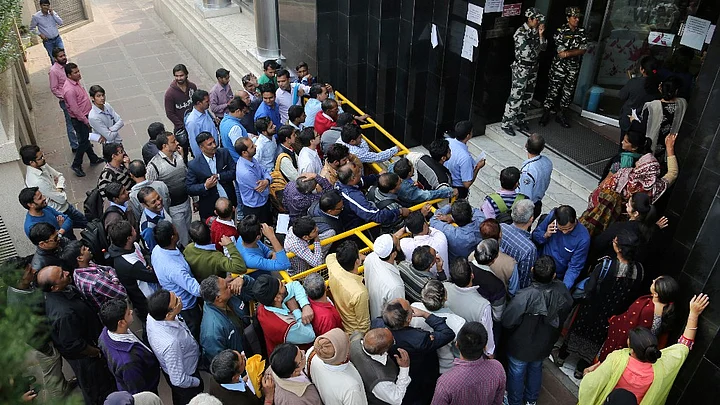A change in regulations on withdrawals, exchange and deposits of currency once every three days. That’s the average run rate the Reserve Bank of India (RBI) has maintained since Narendra Modi announced the demonetisation scheme six weeks ago.
Some may argue that most of these took place in November, but the sheer number of flip-flops in regulations has left a lot of people confused.
The latest change, 11 days before the deadline to deposit demonetised Rs 500 and Rs 1,000 notes came on Monday. You are now required to give a “satisfactory explanation” to two bank officials if you want to deposit more than Rs 5,000 in scrapped notes from now till 30 December.
Here’s a list of just how many times, and how many new rules have been brought in since 8 November.
8 November: Prime Minister Modi announces that Rs 500 and Rs 1,000 notes are scrapped. You were told that you could exchange these for Rs 4,000 at bank branches.
10 November: Withdrawal limit set at Rs 10,000 per day, and Rs 20,000 per week.
11 November: RBI assures you that you have enough time to exchange your old notes.
The Reserve Bank appeals to members of public to be patient and urges them to exchange their old notes at their convenience, any time before 30 December 2016.RBI’s 11 November notification
12 November: The RBI once again calls for calm.
13 November: Exchange limit raised to Rs 4,500 per day. Daily ATM withdrawal limit increased to Rs 2,500 per day from Rs 2,000 in recalibrated ATMs.
Withdrawal limit from branches increased to Rs 24,000 a week; daily limit removed.
14 November: If you are a District Central Cooperative bank customer, you can withdraw Rs 24,000 per week. However, you cannot exchange old notes for new ones, or deposit old notes.
Current account holders can withdraw Rs 50,000 per week.
15 November: At this point, you may have got inked. Banks started using indelible ink to identify people queuing up to exchange old notes.
17 November: Exchange limit changed for the third time, reduced to Rs 2,000 per day.
18 November: Cash withdrawal through point-of-sale systems across all cities made uniform at Rs 2,000 per day per account.
21 November: If you were getting married, you were allowed to withdraw a maximum of Rs 2,50,000 from a single account. But you had to provide a host of reasons to prove that you needed the cash for your wedding.
Current, overdraft and cash-credit accounts, which were operational for three months or more, allowed to withdraw up to Rs 50,000 in cash per week.
23 November: The RBI said scrapped notes would not be accepted as deposits in small savings accounts.
24 November: The RBI changes exchange norms for the fourth time, scraps the facility altogether at bank branches.
It issued a separate statement saying you could continue to exchange your old notes at one of its branches.
25 November: Foreign citizens allowed to exchange their currency notes up to a limit of Rs 5,000 per week till 15 December.
28 November: The RBI said it would allow withdrawals beyond the stipulated limit if one deposited legal currency.
19 December: The customer now needs to explain the delay in depositing old Rs 500 and Rs 1,000 notes.
21 December: The RBI changed the 19 December order, and exempted fully KYC-compliant bank accounts from the Rs 5,000 cap.
(Originally published on Bloomberg Quint)
(At The Quint, we question everything. Play an active role in shaping our journalism by becoming a member today.)
